
BY SCOTT FALLON
STAFF WRITER |
THE RECORD
A toxic chemical that recently raised concerns throughout the region when it was found near the Wanaque Reservoir has been detected in several smaller drinking water supplies that serve more than a dozen North Jersey towns.
Test results compiled by the federal government in the past three years show 1,4-dioxane, a probable carcinogen, in Fair Lawn, Garfield, Pompton Lakes and several other towns that rely heavily on wells. It has also been found in almost 80 other water systems in every part of the state, from Shore towns to Highlands communities.
Environmental officials say there is no imminent health threat from the levels of 1,4-dioxane that were detected, but there is still no clear consensus on how much of the chemical can be in drinking water before it makes anyone ill. The federal government has yet to develop a national standard for the chemical in water supplies. New Jersey does not yet have one. And the standards established in other states vary wildly.
Those whose drinking water has 1,4-dioxane are left with little information or guidance about whether it is dangerous.
“We need direction based on good science,” said Ken Garrison, the borough engineer for Fair Lawn, which supplies water to 32,000 residents. “It’s difficult for a water supplier to do anything without getting guidance from the regulators.”
The findings in North Jersey range from a barely traceable amount in Park Ridge to a sample almost 30 times greater taken from some of Fair Lawn’s wells that are in a Superfund site.
While the amounts of 1,4-dioxane found in North Jersey are incredibly small — the highest recording of 3.24 micrograms per liter in Fair Lawn is equivalent to three drops of water in an Olympic-sized swimming pool — they are important to regulators in setting baselines that determine how much exposure creates a health threat.
Unlike arsenic, PCBs and other dangerous substances that scientists have studied for decades, 1,4-dioxane belongs to a group of chemicals the Environmental Protection Agency classifies as an “unregulated contaminant” because the agency doesn’t have enough data to determine all of its health implications and its prevalence in water supplies.
The chemical, 1,4-dioxane, is a clear, man-made substance used in paint strippers, degreasers and varnishes. It is also created unintentionally when mixing certain chemicals. It blends with water very easily and is difficult to remove.
Drinking 1,4-dixoane can cause liver and kidney damage and is “reasonably anticipated to be a human carcinogen” by the U.S. Department of Health. In 2010, the EPA determined that 1,4-dioxane is more likely to cause cancer than previously thought: Cancer could occur in one person out of 1 million exposed to 0.35 milligrams per liter of the chemical over a lifetime.
The chemical made news recently after it was discovered in groundwater at the Ringwood Superfund site in the Ramapo Mountains, where Ford Motor Co. dumped tons of paint sludge almost 50 years ago. Although that groundwater is in the watershed that supplies the Wanaque Reservoir, 1,4-dioxane has not been detected in the reservoir, which serves up to 3 million people.
But it has been found in water systems that serve Fair Lawn, Garfield, Pompton Lakes, Oakland, Ramsey, Park Ridge, Elmwood Park, Ridgewood, Wallington, Hawthorne, Mahwah and other towns that receive most of their water from wells, according to an analysis of EPA data by The Record.



“TRACE”: A vanishingly small amount, proportionally speaking. IOW: DON’T SWEAT IT.
well then may be we need to see the r w water to someone who will by it.